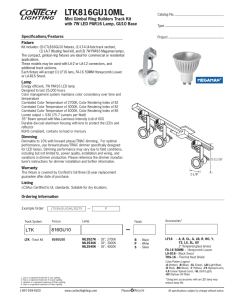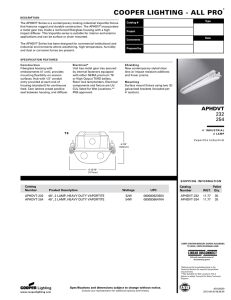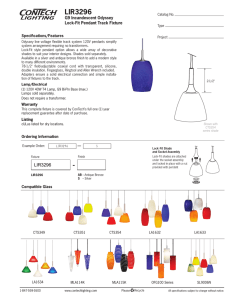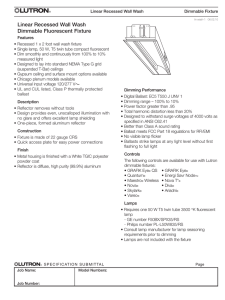New techniques for coating and forming the steel that goes into
advertisement
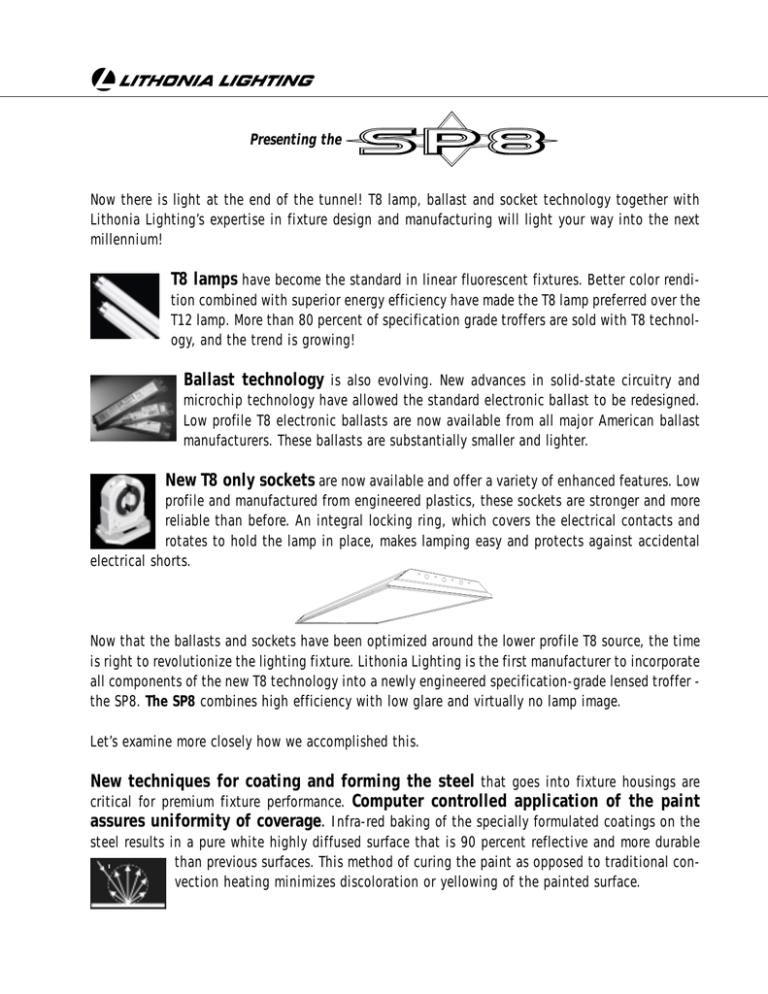
Presenting the Now there is light at the end of the tunnel! T8 lamp, ballast and socket technology together with Lithonia Lighting’s expertise in fixture design and manufacturing will light your way into the next millennium! T8 lamps have become the standard in linear fluorescent fixtures. Better color rendition combined with superior energy efficiency have made the T8 lamp preferred over the T12 lamp. More than 80 percent of specification grade troffers are sold with T8 technology, and the trend is growing! Ballast technology is also evolving. New advances in solid-state circuitry and microchip technology have allowed the standard electronic ballast to be redesigned. Low profile T8 electronic ballasts are now available from all major American ballast manufacturers. These ballasts are substantially smaller and lighter. New T8 only sockets are now available and offer a variety of enhanced features. Low profile and manufactured from engineered plastics, these sockets are stronger and more reliable than before. An integral locking ring, which covers the electrical contacts and rotates to hold the lamp in place, makes lamping easy and protects against accidental electrical shorts. Now that the ballasts and sockets have been optimized around the lower profile T8 source, the time is right to revolutionize the lighting fixture. Lithonia Lighting is the first manufacturer to incorporate all components of the new T8 technology into a newly engineered specification-grade lensed troffer the SP8. The SP8 combines high efficiency with low glare and virtually no lamp image. Let’s examine more closely how we accomplished this. New techniques for coating and forming the steel that goes into fixture housings are critical for premium fixture performance. Computer controlled application of the paint assures uniformity of coverage. Infra-red baking of the specially formulated coatings on the steel results in a pure white highly diffused surface that is 90 percent reflective and more durable than previous surfaces. This method of curing the paint as opposed to traditional convection heating minimizes discoloration or yellowing of the painted surface. 1 Roll forming equipment then precisely forms the steel without the scratches associated with traditional die forming. This high-speed method of manufacture ensures consistent accuracy of parts and makes possible the forming of much more complex shapes than are possible with traditional presses. Roll formers are also more flexible, allowing short runs of different fixture configurations and increasing Lithonia Lighting’s ability to service the market. Two-by-four and 2x2 fixtures are now available in both grid and flanged versions. The SP8 housing has been contoured specifically for the T8 lamp. Faceted sides combine with the 90 percent reflective housing surface to produce a fixture that is over 83 percent efficient in a 2x4 fixture with three lamps. Light dispersing ridges behind each lamp add structural strength to the housing and help kick out light from behind the lamps. New refinements in the lens design increase strength and efficiency and reduce lamp image. Our patented reverse apex lens design has precisely engineered straight prism faces to control light output into specific zones for low glare, better uniformity and better visual comfort. By inverting the top portion of the prism, the lens takes advantage of the imaging properties of two prisms oriented in opposite directions for greater dispersion of light on the lens surface. Together with the design of the housing and the 90 percent reflective diffuse paint, this lens virtually eliminates lamp image. The enhanced visual comfort and the elimination of lamp image results from a combination of several factors. The highly diffuse paint on the housing scatters the light from the lamps to create an even pattern of light on the lens. The high reflectivity causes the lamp image to blend in with the housing to further obscure lamp image The low profile ballast cover is beveled to reduce any shadowing. Low profile T8 sockets maintain the optimum distance between the lamps and the lens. All of this combined with the premium, reverse prism, A12 lens standard on the SP8 virtually eliminates lamp image and enhances the visual comfort (VCPs). In addition to the premium luminaire performance, the SP8 also features many structural enhancements. The long edges of the fixture have been rolled and hemmed, and the end plates have been rolled inward to produce a fixture with no exposed sharp edges. The edges of the doorframe have also been rolled and hemmed to eliminate sharp edges and improve strength. The thicker edges give an appearance similar to extruded doorframes. The wider doorframe (.75”) is painted with paint to match the gloss level of the ceiling grid. The cross section of the doorframe is no longer the “C” shape so common in the industry, but a much stronger “T” shape. The door will accommodate all standard lenses and paracube louvers. Each corner of the doorframe is cut to a precise 45-degree flat miter providing for a more aesthetic picture frame appearance. In addition, each mitered corner is reinforced with double push-back tabs and a centering key for alignment, strength and the prevention of light leaks. This unique design allows for removal of lenses up to .156" thick without disassembling the door. Simply remove the lens retention clips and flex the lens out. A new lens can be installed by simply reversing the process. To help prevent light leaks, the back of the doorframe has been painted black. When the doorframe is closed, this black surface joins with the specially contoured housing and prevents light leaks without the use of any gasketing or foam tape. The hinge and latch have also been redesigned. The gauge of the T-hinge has been increased and reshaped so the door can be easily removed by simply lifting it up and out when the door is hanging open. No searching for the right angle for hinge removal and insertion. The latch is constructed of one piece of spring steel and is designed to open with no tools needed and snap shut with only one hand. The door closure has passed the Uniform Building Code, Edition 1997, and the California Building Code, Edition 1998. The housing has also been designed for increased strength and rigidity. Special highstrength steel (45 ksi) and embossed structural ridges have been incorporated in the end plates. The ridges behind each lamp designed to increase fixture efficiency also have the added benefit of strengthening the housing. The fixture can now withstand 3,200 pounds of load without crushing. Integral T-Bar clips are standard. The SP8 is the lowest profile specification-grade lensed troffer on the market today. Its compact 3.65" deep housing provides for easy handling and installation while at the same time delivers the premium performance you demand from a specification-grade troffer. The tradi3.65” tional 2.0” lamp-to-lens distance of the original fixture is maintained. 2.00” The SP8 by design is easier to install and service. The shallow profile will fit in most any plenum design. The premium T8 sockets, low profile ballast cover and unique housing shape make relamping and servicing the ballast easier than ever before. By incorporating the latest T8 technology with innovative fixture design, low-profile no longer has to mean compromised performance in lensed troffers. Efficiency over 83 percent, virtually no lamp image, improved VCPs, easier to install and maintain, better looking and stronger, the SP8 is the next generation of Specification Grade Lensed Troffers.
